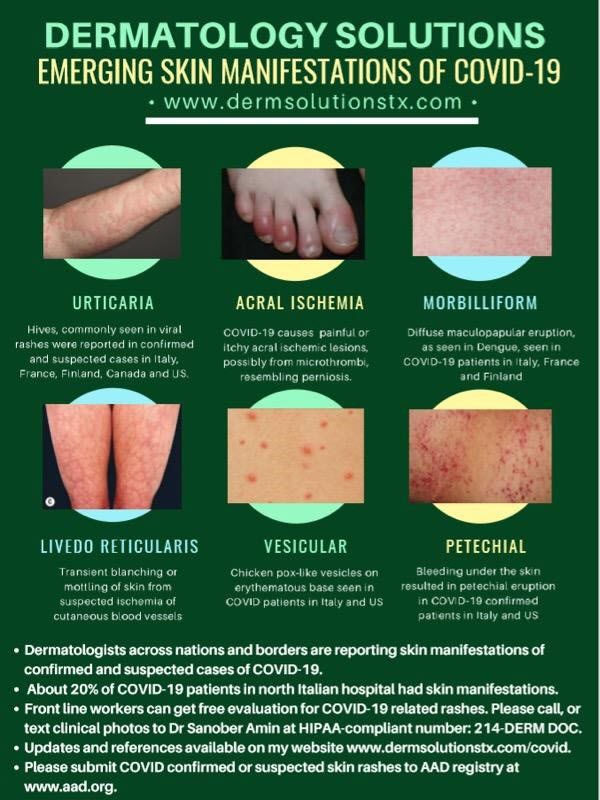
COVID-19 and Skin Conditions: What We Know So Far

Growing evidence shows that COVID-19 can affect almost every organ, including the skin. Dermatologists around the world are sharing images and information about various kinds of rashes and skin-related effects that may be associated with COVID-19. There are so many different types of skin findings being reported that the American Academy of Dermatology has created an international registry to collect and evaluate this information from around the globe.
As experts work to figure what pieces fit in the COVID puzzle and what pieces don’t, it’s important for us to remember that we are still in the early phases of this new disease. It will take time for dermatologists to figure out which skin findings are actually associated with COVID and which ones may have no connection (skin findings may be caused by other diseases and drug reactions, for example).
While reports of skin involvement that may be associated with COVID have run the gamut from whole body rashes to small lumps on the toes and fingers, it will be very interesting to see which manifestations pan out as part of the COVID picture and which do not. In the long run, we may be able to use skin findings to help us figure out if someone is likely to have had the disease, and it might help inform us if someone without other symptoms should be tested. And if we learn the underlying reason for the skin changes, it may give us clues about how the disease behaves in our bodies.
What types of rashes have been reported?
One study published with data from Italy described the skin findings from 88 patients. About 20% had some sort of rash; 8 people had skin findings at the beginning of their infection and 10 people had skin findings after they were hospitalized. The types of rashes ranged from red areas over large parts of the body, to widespread hives, and one finding of a chickenpox like blistering rash. There didn’t seem to be any connection between skin effects and severity of illness.
In another study from Thailand, researchers describe a rash in a patient that was initially thought to be Dengue, but the patient later tested positive for COVID-19.
Recently, ICU patients in New York City were found to have another type of skin manifestation that could be part of the increased blood clotting that doctors are seeing in severely ill patients. Skin biopsies from the rashes in these patients have been linked to tiny blood clots under the skin.
A lot of us have also been hearing a lot about “COVID toes” in the media. According to media reports, many dermatologists are seeing these red bumps on the toes (and fingers) of younger people, especially those who may have had mild or asymptomatic COVID. The medical word for them is “pernio” – and they are usually associated with cold weather. It’s possible that these finding may be associated with immune system effects after infection with the new coronavirus.
What do these rashes look like?
Recently, a dermatologist from Grapevine, TX, Sanober Amin, MD, PhD, started putting images together based on what she was seeing in her own practice, published reports, and information from dermatologists around the world. Her work has been shared widely as she encourages other dermatologists to input skin findings they are seeing into the international registry.
Amin explains that some findings can be confused with the widespread rashes that can be seen in other viral infections, but some seem to reflect the blood clotting problems we are seeing in patients with more severe disease. Though we don’t yet know for sure which skin rashes may suggest infection, or even a previous infection, with COVID, it’s a good idea to keep an eye out for new rashes and to share this information with your doctor.

SOURCE:
BY NEHA PATHAK, MD APRIL 30, 2020, "www.webmd.com", https://blogs.webmd.com/webmd-doctors/20200430/covid19-and-skin-conditions-what-we-know-so-far.
You Might Also Enjoy...


How NightLase® Can Help With Snoring

How Laser Therapy Can Help Decrease Vaginal Dryness and Increase Sexual Pleasure

Five Signs You Could Be Suffering From Low Testosterone

Why Do I Still Get Acne, and How Can I Get Rid of It Without Medication?


